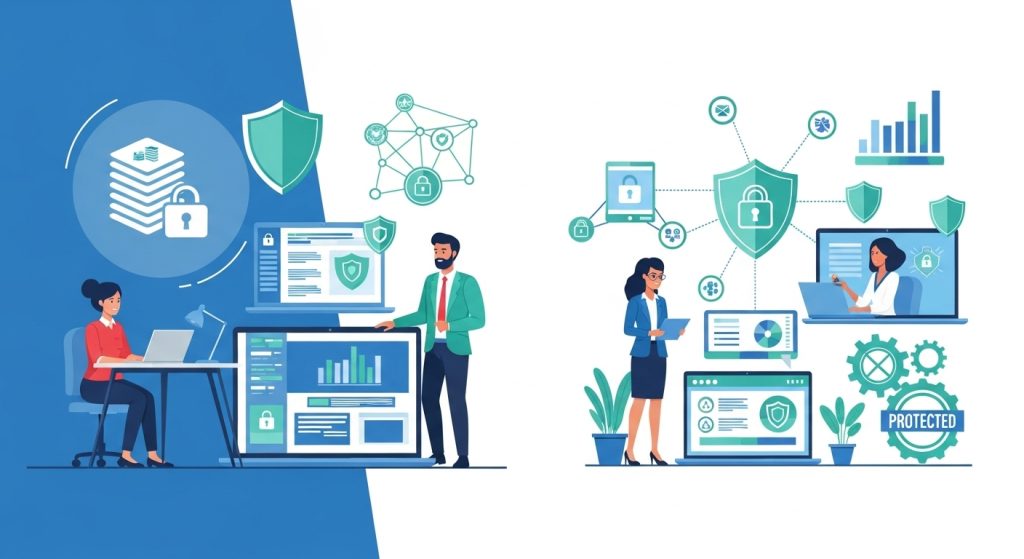In today’s digital landscape, small business cybersecurity has become a critical survival factor. With 43% of cyber-attacks targeting small businesses and 60% of small businesses shutting down within six months after a cyberattack, implementing robust cybersecurity practices is no longer optional—it’s essential for business continuity.
Small businesses face unique challenges in the cybersecurity realm. Companies with fewer than 100 employees receive 350% more threats than larger companies, yet only 14% of small and medium businesses are prepared to face such attacks. This alarming gap between threat exposure and preparedness makes understanding business cyber protection strategies more crucial than ever.
15 Common Mistakes Beginner Programmers Make in JavaScript
The Current State of Small Business Cyber Threats
The cybersecurity landscape in 2025 presents unprecedented challenges for small businesses. Ransomware-as-a-Service (RaaS) has grown by 60% in 2025, making it easier for amateur hackers to launch attacks, while 81% of cybercriminals are now leveraging AI-powered tools to improve attack success rates.
The financial impact is staggering. Cybercrime is set to cost businesses up to $10.5 trillion by 2025, with the average cost of a data breach reaching $4.88 million. For small businesses operating on tight margins, even a fraction of this cost can be devastating.
10 Essential Cybersecurity Practices Every Small Business Must Implement
1. Establish Strong Password Management
Implementing robust password policies is the foundation of effective small business security. Weak passwords remain one of the most common vulnerabilities exploited by cybercriminals.
Best Practices:
- Require passwords with minimum 12 characters
- Mandate use of uppercase, lowercase, numbers, and symbols
- Implement password manager solutions
- Enforce regular password updates every 90 days
Tools to Consider:
- LastPass Business
- 1Password Business
- Bitwarden Business
2. Enable Multi-Factor Authentication (MFA)
Multi-factor authentication drastically improves online safety by adding an extra layer of security beyond passwords. This cybersecurity practice significantly reduces the risk of unauthorized access.
Implementation Strategy:
- Enable MFA on all business accounts
- Use authentication apps rather than SMS when possible
- Require MFA for administrative access
- Train employees on proper MFA usage
3. Keep Software and Systems Updated
Having the latest security software, web browser, and operating system are the best defenses against viruses, malware, and other online threats. Regular updates close security vulnerabilities that cybercriminals exploit.
Update Schedule:
- Install critical security patches immediately
- Schedule regular system updates monthly
- Enable automatic updates where possible
- Maintain an inventory of all software requiring updates
7 Common Mistakes in Personal Finance Management
4. Deploy Comprehensive Antivirus and Anti-Malware Solutions
With more than 1.2 billion malware programs in existence, robust endpoint protection is essential for business cyber protection.
Protection Strategy:
- Install enterprise-grade antivirus on all devices
- Enable real-time scanning and monitoring
- Schedule regular full system scans
- Keep virus definitions updated automatically
5. Implement Regular Data Backup Procedures
Since 75% of SMBs say they could not continue operating if hit with ransomware, having reliable backup systems is crucial for business continuity.
Backup Best Practices:
- Follow the 3-2-1 rule: 3 copies, 2 different media, 1 offsite
- Test backup restoration procedures regularly
- Encrypt all backup data
- Automate backup processes to ensure consistency
6. Secure Network Infrastructure
Network security forms the perimeter defense for your small business cybersecurity strategy.
Network Security Measures:
- Install and configure firewalls properly
- Use WPA3 encryption for wireless networks
- Segment networks to limit access
- Monitor network traffic for anomalies
- Change default router passwords immediately
7. Provide Comprehensive Employee Cybersecurity Training
Human error, such as clicking on phishing emails or using weak passwords, is one of the leading causes of breaches. With 30% of small businesses viewing phishing as their biggest cyber threat, employee education is critical.
Training Components:
- Monthly cybersecurity awareness sessions
- Phishing simulation exercises
- Security protocol documentation
- Incident reporting procedures
- Social engineering awareness
8. Control Access and Permissions
Implementing proper access controls limits potential damage from both internal and external threats.
Access Management Strategy:
- Apply principle of least privilege
- Regular access reviews and updates
- Remove access immediately upon employee departure
- Use role-based access controls
- Monitor privileged account usage
9. Develop an Incident Response Plan
86% of small and medium-sized businesses have conducted an active cybersecurity risk assessment and have a cyberattack prevention plan, but preparation quality varies significantly.
Incident Response Components:
- Clearly defined response team roles
- Step-by-step response procedures
- Communication plans for stakeholders
- Recovery and business continuity procedures
- Regular plan testing and updates
10. Invest in Cyber Insurance
91% of small businesses haven’t purchased cyber liability insurance, despite awareness of risk. This gap leaves businesses financially vulnerable.
Insurance Considerations:
- Coverage for data breach costs
- Business interruption protection
- Legal and regulatory compliance support
- Incident response services
- Reputation management assistance
Digital Detox: Why You Should Take a Break from Screens
Creating a Cybersecurity Culture
Successful cybersecurity practices require more than just technology—they need organizational commitment. Getting buy-in from stakeholders and understanding business goals and translating cyber risks are essential for effective implementation.
Budget-Friendly Cybersecurity Implementation
Small businesses don’t need enterprise-level budgets to implement effective small business security measures:
| Priority Level | Low Cost ($0-$500) | Medium Cost ($500-$2,000) | Higher Investment ($2,000+) |
|---|---|---|---|
| Essential | Password managers, basic antivirus, employee training | MFA solutions, backup services, firewall upgrades | Comprehensive security suite, cyber insurance |
| Important | Software updates, access controls, basic monitoring | Network security tools, advanced training | Managed security services, incident response planning |
| Advanced | Security policies, awareness programs | Vulnerability scanning, security assessments | Professional security consultation, compliance tools |
Measuring Cybersecurity Effectiveness
Track these key metrics to evaluate your business cyber protection program:
- Number of security incidents detected and resolved
- Employee compliance with security policies
- Time to detect and respond to threats
- Percentage of systems with current security updates
- Regular security assessment results
Simple Morning Routines That Can Change Your Life
Frequently Asked Questions
What are the most important cybersecurity practices for small businesses?
The most critical cybersecurity practices for small businesses include implementing strong password management with multi-factor authentication, keeping all systems updated, deploying comprehensive antivirus protection, conducting regular employee training, and maintaining secure data backups. These foundational measures address the majority of common threats targeting small business cybersecurity.
How much should small businesses spend on cybersecurity?
Small businesses should allocate 3-7% of their IT budget to small business security measures. This typically ranges from $500-$5,000 annually for very small businesses, depending on size and industry. The investment in business cyber protection is significantly less than the average cost of a data breach, making it a crucial business expense rather than optional spending.
What is the biggest cybersecurity threat to small businesses in 2025?
30% of small businesses view phishing as their biggest cyber threat, making it the most significant risk. However, ransomware attacks have also increased dramatically, with Ransomware-as-a-Service growing by 60% in 2025. Both threats can be mitigated through proper employee training and robust cybersecurity practices.
Do small businesses really need cyber insurance?
Yes, cyber insurance has become essential for small business cybersecurity strategies. With 60% of small businesses shutting down within six months after a cyberattack and 91% of small businesses lacking cyber liability insurance, this gap represents a significant business risk. Cyber insurance provides financial protection and incident response support that most small businesses cannot afford to provide internally.
How to Make Money Online Using Amazon Affiliate Marketing
Secure Your Business Future Today
Implementing these essential cybersecurity practices isn’t just about preventing attacks—it’s about ensuring your business survives and thrives in an increasingly digital world. With cyber threats growing more sophisticated each year, the time to act is now.
The cost of prevention is always less than the cost of recovery. Start with the basics: strong passwords, regular updates, and employee training. Then gradually build your small business security program to include more advanced protections.
Ready to strengthen your cybersecurity defenses? Get comprehensive protection with enterprise-grade security solutions designed specifically for small businesses.
Antivirus & Endpoint Security Software:
Business-Grade Routers & Firewalls:
Cloud Backup & Data Recovery Services:
for exclusive discounts on cybersecurity tools and services.
Don’t become another statistic. Protect your business, your customers, and your future with proven cybersecurity practices starting today.











